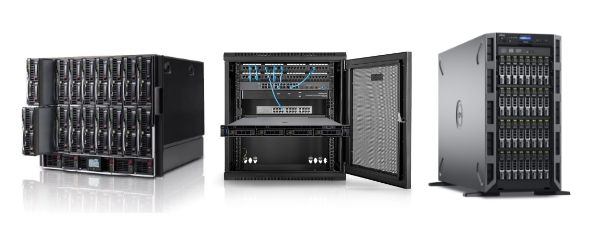Tired of overloaded servers that can’t keep up with your company’s growth? Instead of investing in another expensive “just-in-case” machine, it’s worth considering a natively scalable solution - a compute cluster. In a cluster computing model, multiple nodes are combined into a single environment that grows in line with your requirements. This approach provides not only more processing power, but also higher availability, flexibility, and greater control over resources. Learn how a cluster works, how it differs from a traditional server, and in which scenarios it can make a real difference - including cost efficiency.
Cluster computing in practice - combining multiple servers into one compute platform
When your demand for processing power grows and vertical scaling (upgrading a single server) becomes uneconomical or technically impossible, the natural step is combining multiple physical servers into a single logical environment. This is the foundation of cluster computing - an architecture that distributes workloads across independent machines while maintaining global consistency and unified management. From the application’s perspective, such a system behaves like a single host, even though under the hood it may be powered by dozens or even hundreds of nodes.
This model has long been a standard in large enterprises and research institutions but is increasingly adopted by mid-sized companies as well. Why? Because it allows organic, step-by-step infrastructure expansion - you simply add nodes when the demand grows, without replacing the entire setup. Besides cost efficiency, clusters provide greater failure tolerance - if one node goes down, the system remains operational. Scalability, flexibility, and high availability are the three critical advantages this concept holds over the classical “one high-performance server” approach.
Cluster vs single server - why one is hardware, the other a strategy
At first glance, a cluster may look like “just several servers in a rack.” In practice, however, a compute cluster is not merely a set of machines - it’s an architectural strategy for resource management, scalability, and redundancy. Unlike a standalone server, which operates in isolation, a cluster is a distributed system that provides workload balancing, scheduling, and built-in high availability. It represents a fundamentally different mindset in IT environment design, requiring different planning, administration, and security models.
For companies that cannot rely on a single point of failure, clusters become the natural choice. Workloads can be distributed across nodes, nodes can assume different roles, and they can be replaced on-the-fly without downtime. This level of elasticity is unattainable even on the most powerful standalone servers. Therefore, when evaluating a cluster rollout, the focus should not be limited to hardware itself - it’s about transforming the operational model of the entire IT department and the company’s architecture.
How does a compute cluster work? Inside distributed systems
At the core of a cluster lies the mechanism that splits workloads across multiple physical machines. This is where the fundamental difference between a standard server and a compute cluster emerges. Each node has its own CPU, RAM, and storage, but jobs are centrally scheduled - typically by a job scheduler or workload management system. Such middleware analyzes current resource availability and allocates tasks to optimize throughput and minimize execution time.
Practically, clusters can execute hundreds of high-demand operations in parallel - from financial modeling to scientific simulations, big data analytics, or AI model training - all without risking that one application bottlenecks the entire system. Modern clusters also support dynamic provisioning and de-provisioning of nodes, allowing seamless workload scaling in line with business needs. Instead of designing “capacity in advance,” you can incrementally extend performance exactly when it’s required.
Compute clusters vs vertical scaling - what truly works in 2025
Vertical scaling - adding resources to a single server - faces clear physical, financial, and technological limits. Core counts, memory bandwidth, and I/O capacity cannot be increased indefinitely, and any hardware failure results in a critical outage. These are the reasons why organizations are shifting towards clusters, which offer not only higher scalability, but also increased resilience and predictable long-term cost models.
In 2025, it’s nearly impossible to imagine efficient environments for AI applications, engineering simulations, or complex virtualization stacks without compute clusters. Monolithic all-in-one servers stop scaling effectively, whereas clusters scale horizontally - precisely when demand grows. Moreover, modern frameworks (from Kubernetes to OpenHPC) provide automated and secure management of such distributed environments. If you’re planning for the long term, architecture that ensures both computational power and operational governance is a necessity.
Cluster PC in enterprise workflows - viable even at smaller scales
Although “Cluster PC” deployments are commonly associated with academia or large institutions, in practice smaller-scale businesses can also leverage them effectively. The critical factor is not the absolute cluster size, but the type of workloads being executed. If your applications frequently overload standalone servers or require bursts of compute power during specific timeframes, a cluster can prove more cost-effective and performant than an additional monolithic server.
With modern resource-management platforms, even a compact 3–4 node cluster can deliver parallel processing, improved resource utilization, and reduced downtime risk. Furthermore, such setups can be built with recertified hardware instead of only brand-new systems. For dynamic, project-based, or seasonal IT environments, clusters introduce flexibility far beyond what a classical server can achieve.
Is a compute cluster always the better option? Efficiency factors
Cluster performance is determined by a wide set of parameters - from interconnect bandwidth and latency, software configuration, to the intrinsic characteristics of jobs being executed. Not all applications parallelize well, and some processes resist distribution across nodes. Before investing, it’s crucial to test how your technology stack behaves in a distributed context. Otherwise, you may own excellent hardware without achieving real-world efficiency improvements compared to a single high-performance server.
Achieving optimal results requires deliberate planning, test cycles, and continuous tuning. Data locality must be managed properly, workloads must avoid idle dependencies, and monitoring tools should highlight bottlenecks. A well-designed cluster doesn’t just enhance performance - it creates a system that dynamically responds to load, automatically balances tasks, and maintains constant uptime without resource contention.
High availability and load balancing - what cluster computing means for your applications
For many businesses, uninterrupted service availability outweighs raw performance as the primary reason for deploying clusters. In single-server architectures, every outage halts critical applications, leading to real business losses. In cluster-based environments, redundancy mechanisms prevent such scenarios - nodes automatically take over duties when one fails, enabling self-healing.
The second foundational element is dynamic load balancing. Tasks are distributed in real time based on actual node availability, ensuring stable performance even during sudden demand spikes. This not only enhances reliability, but also maximizes existing resource utilization. Instead of oversizing a single server, clusters allow you to build adaptive environments that scale intelligently and remain resilient when it matters most.

































